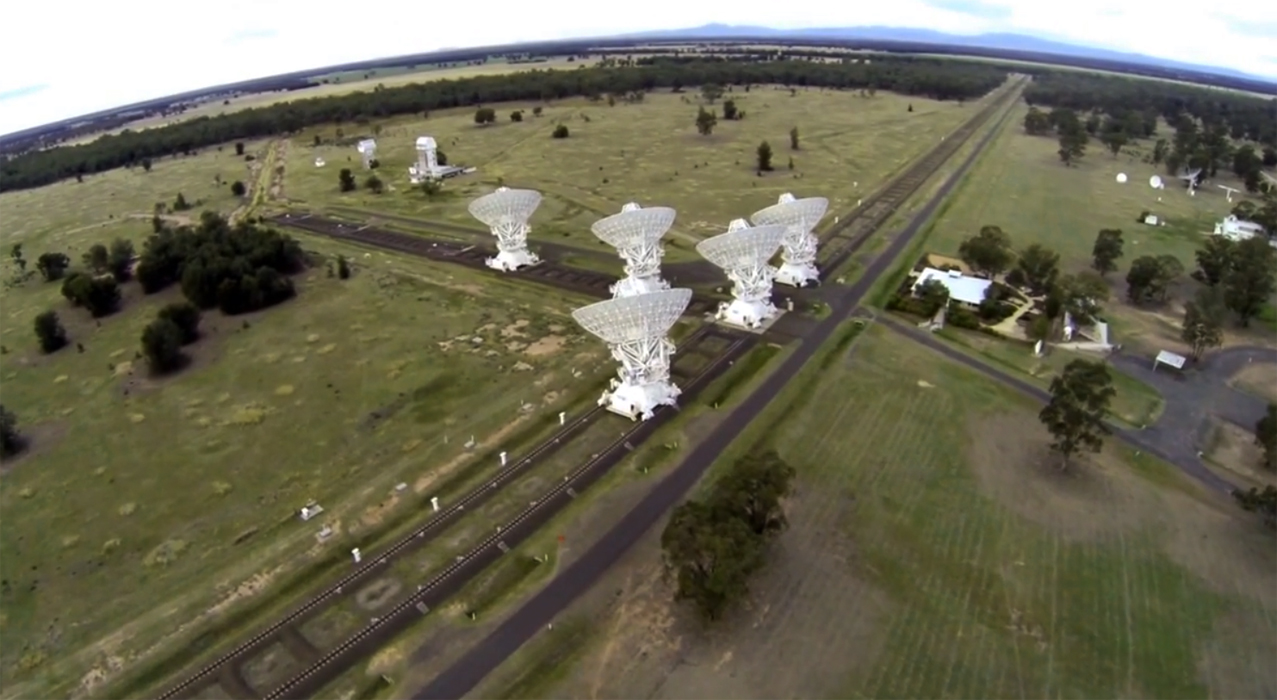It’s only been a few short weeks since we celebrated the 25th anniversary of the Australia Telescope Compact Array in Narrabri, and today we’re marking another special occasion – the 400th reconfiguration of the ATCA antennas.
The ATCA is reconfigured on average every three weeks or so, and a full day is allocated to this task. By changing the positions of the antennas, astronomers can alter the baselines to optimise their observations.
Five of the six antennas of the Australia Telescope sit on 3km long railway track that runs east-west, and they are free to move along the track. There is also a short track that runs north-south at the mid-point of the main track. The sixth antenna sits in a fixed position a further 3km west.
A birds-eye view of the five movable ATCA antennas, sitting on the 3km long east-west track (marked by a blue rectangle that runs horizontally along the photo), with the 214m north-south spur also marked at the mid-point of the main track. Each of the antennas are named CA01-05. The sixth antenna (CA06) is 3km to the west of the image. Click to enlarge.
There are now 17 standard configurations, and roughly half of these are offered to observers each observing semester (six month periods that begin in April and October), with different combinations cycled through based on the desired observing frequency and angular resolution of observers.
Along the tracks, there are 44 fixed ‘station posts’, 39 on the east-west track and five on the northern spur. These station posts provide mains power to the antennas and allow the antennas to communicate with the control building.
To reconfigure the positions of the antennas, they are disconnected from their station post and driven to their new location. And when I say driven, that exactly what happens, at the top speed of around 5km/hr (remember when Bob Hawke drove the antenna down the track at the Opening Ceremony?).
Each antenna also has its own generator that keeps the electronics running and receivers cooled during the reconfiguration, and powers the antenna to move to a new location.
During the ATCA 25th Anniversary Science Symposium held during the week following the Open Day, the following statistics were compiled:
- The smallest baseline increment available is 15.306 m.
- The shortest physical baseline is 30.612 m, and the longest is 6 km.
- Longest time spent in one configuration: 118 days; during 13 October 1993 – 8 February 1994, the antennas sat in a 6 km array.
- Shortest time spent in one configuration: 3 days; during 10-13 January 1992.
- The most common length of time spent in one configuration: 14 days.
- The most ‘popular’ array is known as 6A; this configuration has been scheduled 45 times – a cumulative total of four years! In this array, the antennas are at their widest spacing, providing the best angular resolution for observations – ideal for observations of sources such as distant galaxies.
In fact, the 400th reconfiguration will mean moving the antennas in to the 6A configuration, from a ‘hybrid’ array, which is a compact configuration with two antennas on the northern spur and three sitting close by on the east-west track.
An example of a compact hybrid array, where the antennas are positioned closely together on the east-west track and the northern spur. Source: Jamie Stevens, CSIRO.
In order to move two antennas from the northern spur and back on to the east-west track, these antennas need to be jacked up (like a car) in order to rotate the wheels 90 degrees before moving on to the main track.
Once the antennas are moved, cables will be attached to the station post so the antennas can once more communicate with the control room.
In the evening, staff will calibrate the antennas by putting them through a series of observations to accurately measure their new orientation and location.
All in all, it usually takes about four people to disconnect, move and reconnect the antennas, and another involved in the recalibration. If the weather is cooperative, then usually by midnight the array is ready to start observing in its new configuration.
Now you know how it works, take a look at the following video from astronomer Emil Lenc, which shows a high speed version of a reconfiguration.
If you’re curious to know where the antennas are positioned and what they’re looking at, check out the Australia Telescope Compact Array – Live!, where you will be able to check in on the local time, weather, wind speed and direction, the configuration of the array and what project is currently being observed.




18th February 2018 at 6:56 pm
It is fabulous that Australia continues to be world leaders in innovation in the science world that contributes to the most important aspect of human endeavours; understanding!
Go Aussie go!